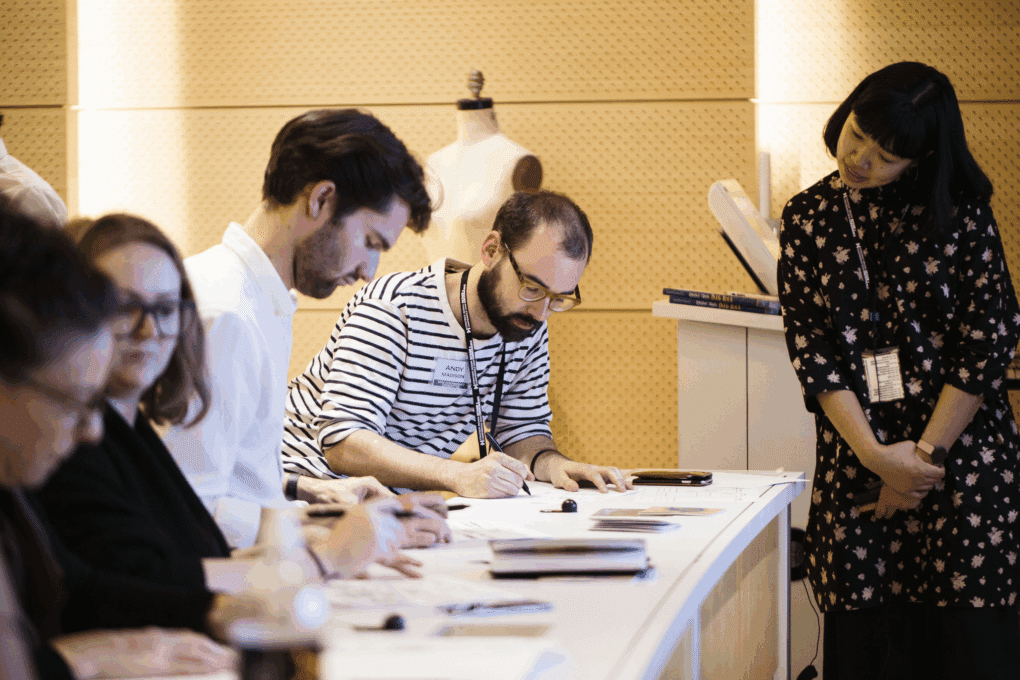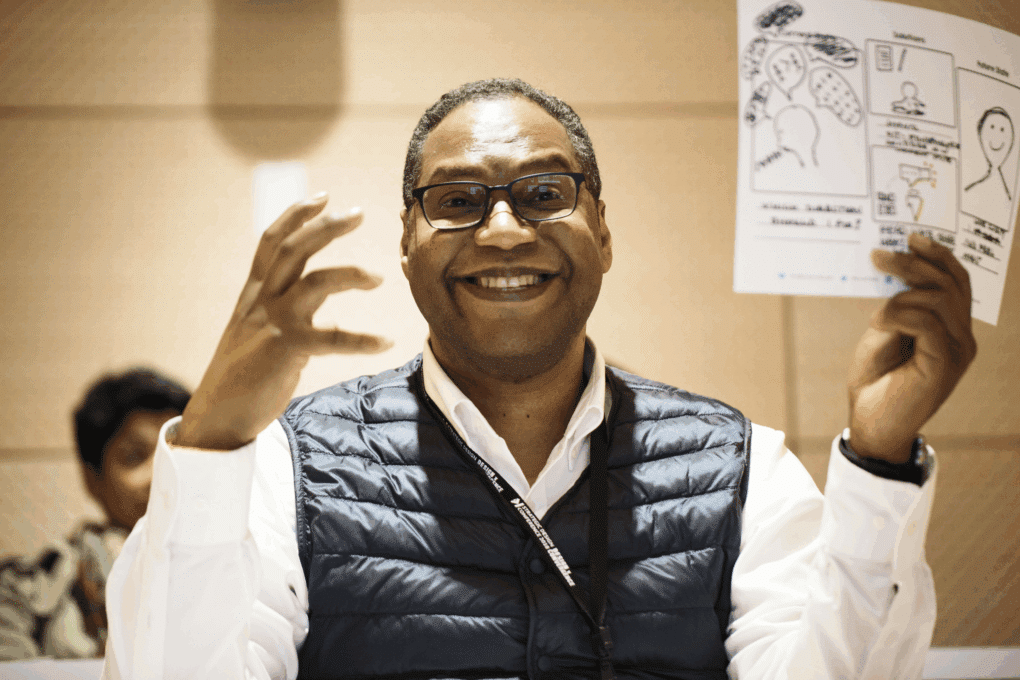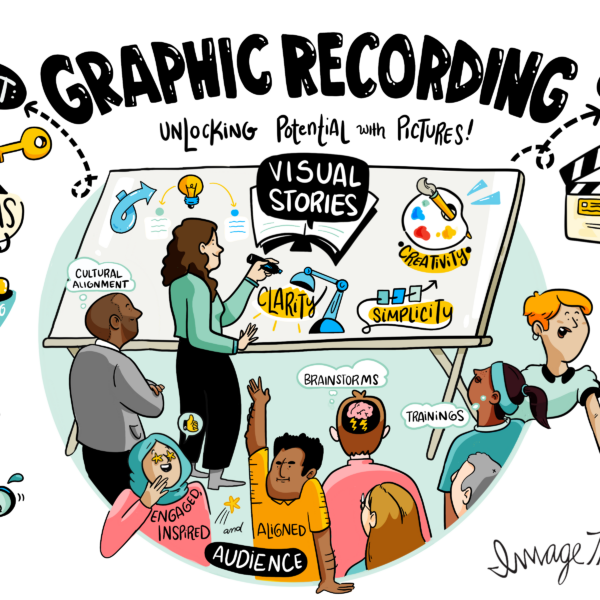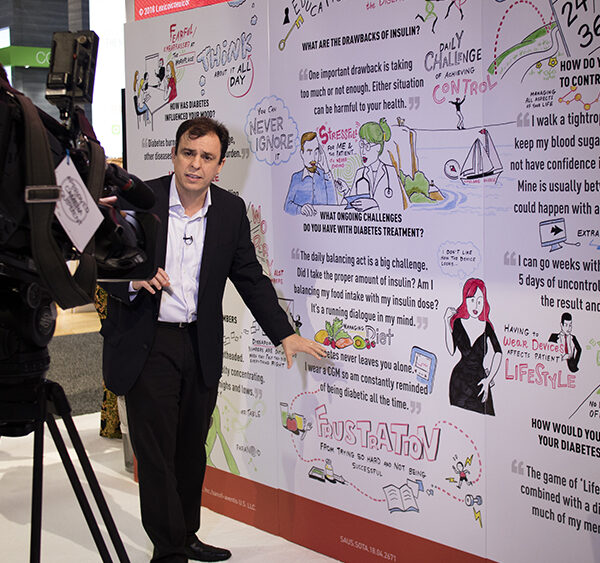The conference room fell silent as the healthcare executive stared at the whiteboard. After three months of strategy meetings, her team was still talking in circles about their patient experience initiative. Then something shifted. Instead of another PowerPoint presentation, we handed out markers and invited everyone to sketch their vision of the ideal patient journey—together, in real time.
What happened next transformed not just the project, but how this organization approaches collaboration entirely. Within two hours, stakeholders who had been debating for months suddenly found alignment. The breakthrough came when the CEO drew a simple stick figure walking through a maze, and the head of patient services added bridges over the dead ends. That visual metaphor became the foundation for their entire patient experience strategy.
This is the power of visual cocreation—when clients become true partners in building solutions rather than passive recipients of presentations.
What Is Cocreation and Why Does It Change Everything?
Picture this: You’re in a typical client meeting. You’ve spent weeks crafting the perfect strategy deck. You present slide after slide of insights, frameworks, and recommendations. The client nods politely, asks a few questions, then says those dreaded words: “Let us think about it and get back to you.”
Now imagine a different scenario. The same client challenge, but this time you’re standing at a large whiteboard with the entire leadership team. Instead of presenting your solution, you’re building it together. The CMO adds a customer insight. The CFO sketches out budget implications. The CEO connects the dots between market opportunity and operational reality.
By the end of the session, you don’t have “your recommendation” and “their feedback.” You have a shared vision that everyone helped create—and everyone is committed to implementing.
This is cocreation in action. It’s the practice of developing solutions with clients, not for them, using visual thinking as the bridge between different perspectives and priorities.

The Day Everything Changed: A Real Cocreation Story
Last year, we worked with a technology startup struggling to define their go-to-market strategy. The founding team had been debating their approach for months. The CEO wanted to focus on enterprise clients. The CTO believed small businesses were the better opportunity. The head of sales was convinced they needed a freemium model.
Traditional consulting would have meant interviewing each stakeholder separately, analyzing their input, and presenting a recommendation. Instead, we brought everyone into a visual cocreation session.
We started by asking each person to draw their vision of the ideal customer. The CEO sketched a corporate building with multiple floors. The CTO drew a small storefront with a “help wanted” sign. The sales leader illustrated a funnel with many small fish entering and a few large fish emerging.
Then something magical happened. Looking at these drawings side by side, the team realized they weren’t actually disagreeing about the customer—they were describing different stages of the same customer journey. Small businesses that grow into enterprises. The “aha moment” was visible on their faces.
Within three hours, they had a unified go-to-market strategy that incorporated everyone’s insights. Six months later, they closed their Series A funding round, crediting the clarity of their strategy as a key factor in investor confidence.
Why Our Brains Crave Visual Collaboration
There’s science behind why visual cocreation works so powerfully. When we engage both visual and verbal processing simultaneously, our brains create stronger neural pathways. Information becomes more memorable, more meaningful, and more actionable.
But there’s something deeper happening too. When clients help create the solution, they develop what psychologists call “ownership bias”—a stronger attachment to ideas they’ve contributed to building. It’s the difference between being told what to do and discovering what needs to be done.
I’ve watched this transformation hundreds of times. The moment a client picks up a marker and adds their insight to a shared visual, their entire posture changes. They lean in. They engage more actively. They become invested in the outcome because they’re invested in the process.
The Tools That Make Magic Happen
The magic isn’t in the tools—it’s in the invitation to think together. But having the right setup removes barriers to participation.
For in-person sessions, we keep it simple: large format paper, colorful markers, and plenty of sticky notes. The goal is to make visual thinking feel accessible, not intimidating. We’ve seen executives who “can’t draw” create powerful visual metaphors when the pressure is off and the focus is on ideas, not artistic skill.
Virtual collaboration opens new possibilities. During a recent session with a distributed team, we used digital whiteboards to map their customer experience across time zones. Team members in London, New York, and San Francisco were sketching together in real time, building on each other’s insights despite being thousands of miles apart.
The key is choosing tools that feel natural for your specific client. Complex software can create barriers; simple, intuitive approaches encourage participation.
When Stakeholders Finally See Eye to Eye
The most powerful moment in any cocreation session is when alignment becomes visible—literally. I remember working with a pharmaceutical company where different departments had been working on patient education materials separately for months. Marketing had one vision. Medical affairs had another. Patient advocacy had a third perspective.
When we brought them together to visually map the patient journey, something remarkable happened. As each department added their piece to the visual story, they realized how much their work overlapped and complemented each other. The marketing team’s awareness campaigns connected perfectly with medical affairs’ educational content, which aligned beautifully with patient advocacy’s support programs.
By the end of the session, instead of three separate initiatives competing for resources, they had one integrated patient experience strategy that leveraged everyone’s expertise. The visual map became their north star, guiding decisions and keeping everyone aligned throughout implementation.
Tips for Facilitating Effective Visual Cocreation Sessions
To run powerful client cocreation sessions, keep these in mind:
- Prep the room and the mindset: Let clients know this will be collaborative, not prescriptive.
- Use frameworks, not formulas: Start with templates but leave space for invention.
- Draw, adapt, evolve: Let the visuals change as the ideas evolve.
- Close the loop: Revisit the visuals as living documents, not snapshots.

From “Your Idea” to “Our Vision”
The transformation from client-vendor to collaborative partner doesn’t happen overnight, but visual cocreation accelerates the process dramatically. When clients contribute to creating the solution, they stop seeing themselves as buyers and start seeing themselves as builders.
I witnessed this shift recently with a nonprofit client struggling with donor engagement. Instead of presenting them with a fundraising strategy, we facilitated a visual storytelling workshop where board members, staff, and even donors sketched their vision of the organization’s impact.
The breakthrough came when a longtime donor drew a simple image of hands passing a torch from one generation to the next. That visual metaphor became the centerpiece of their campaign, not because we recommended it, but because it emerged from their collective wisdom. The campaign exceeded its goal by 150%, but more importantly, the organization discovered a new way of working together that extended far beyond fundraising.
Making Cocreation Work: Lessons from the Field
After facilitating hundreds of visual cocreation sessions, certain patterns emerge. The most successful sessions share common elements:
Start with stories, not strategies. We always begin by asking participants to share a story—about a customer, a challenge, or a success. Stories create emotional connection and shared context before diving into problem-solving.
Make thinking visible from the start. Instead of asking people to think quietly and then share, we encourage thinking out loud while sketching. This transparency builds trust and invites others to build on emerging ideas.
Embrace the messy middle. The most breakthrough moments often come when the visual gets complicated, overlapping, and seemingly chaotic. This is where different perspectives intersect and new possibilities emerge.
Capture everything, judge nothing. Every contribution matters, even ideas that don’t make it into the final solution. Participants need to see their input valued to stay engaged in the process.
The Ripple Effect: When Cocreation Becomes Culture
The most rewarding part of this work isn’t just the immediate project outcomes—it’s watching organizations discover a new way of working together. Clients who experience successful visual cocreation often request it for future projects, not because they have to, but because they’ve seen how much more effective collaboration can be.
One technology client now starts every major initiative with a visual cocreation session. Their CEO told me, “We used to spend months debating strategy in conference rooms. Now we spend hours building it together on whiteboards. The quality of our decisions has improved, and our time to implementation has been cut in half.”
This is the ultimate goal of visual cocreation: not just better solutions, but better ways of creating solutions together.
Your Next Collaboration Revolution
Visual cocreation isn’t just a methodology—it’s a mindset shift that transforms how teams think, decide, and act together. When you invite clients into the creative process, you’re not just improving project outcomes; you’re modeling a more collaborative way of working that can revolutionize their entire organization.
The question isn’t whether visual cocreation works—we’ve seen the evidence in hundreds of sessions across every industry. The question is: are you ready to put down the presentation slides and pick up the markers?
The next time you’re tempted to polish a recommendation in isolation, consider this: what if your biggest breakthrough is waiting to emerge from the collective wisdom of your client team? What if the solution they need isn’t something you create for them, but something you discover together?
That whiteboard is waiting. Those markers are ready. The only question is: what will you build together?
Frequently Asked Questions (FAQ)
What is visual cocreation and how does it work?
Visual cocreation is the practice of developing ideas and solutions in real time with clients using tools like sketching, mapping, and digital whiteboarding. Instead of relying on static presentations, teams build ideas collaboratively—fostering alignment, shared ownership, and faster decision-making.
How does cocreation improve client relationships?
Cocreation turns clients into collaborators, not just approvers. By making decisions together visually, teams build trust, reduce friction, and often see fewer revision cycles. This transparency strengthens long-term relationships and increases satisfaction.
How do you prepare clients for a cocreation session?
Set expectations early. Let clients know artistic skill isn’t required—participation is. Share a light agenda, simple drawing prompts, and encourage open conversation. Use stick figures, shapes, and sticky notes to get ideas flowing without pressure.
What happens if a client can’t draw?
That’s okay—visual cocreation is about thinking, not artistry. Facilitators can translate spoken ideas into sketches. Alternatives like sticky notes or pre-drawn icons keep things moving. The focus is co-ownership, not perfection.
Can cocreation work with remote teams?
Yes. Tools like Miro, MURAL, and Zoom whiteboards make virtual cocreation seamless. While sessions may be shorter to avoid fatigue, many teams find participation increases—especially from quieter voices.
Ready to experience the power of visual cocreation with your team? ImageThink specializes in collaborative visual facilitation that transforms how organizations think and work together. Let’s start building something extraordinary together.




